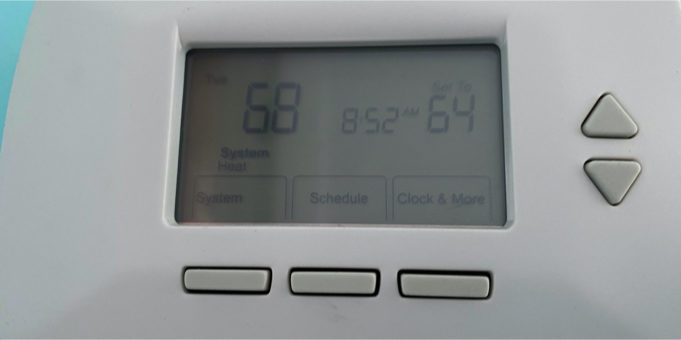Before you get started, you’ll need to pick a programmable thermostat you’ll actually use. According to a study by the Lawrence Berkeley National Lab, nearly 90% of Americans say they’ve rarely (or never) programmed their thermostat because they’re not sure how to do it. But it’s really not that hard, and it’s definitely worth doing because it can save at least 10% a year on heating and cooling costs. The U.S. Department of Energy says you can achieve that 10% by turning your thermostat back 7 to 10 degrees F from it’s normal setting for 8 hours a day.
Pick a Thermostat Suitable for your Home Heating and Cooling System
Before buying a programmable thermostat, identify the type of equipment used to heat and cool your home so you can check for compatibility. For example, do you have central heating and cooling, or just a furnace or baseboard heating? Otherwise, you may not reap the rewards of energy savings and may risk harming your heating and cooling equipment.
Pick a Thermostat Best Suited to Your Family’s Schedule
Then pick the thermostat that best suits your scheduling needs for a “set it and forget it ” approach that the Energy Department advocates to get the most savings. There are four types of programmable thermostats, each with a distinctive scheduling style:
- 7-day programming. Best for individuals or families with erratic schedules, since this is the most flexible option. It lets you program a different heating/cooling schedule for each day of the week.
- 5-1-1 programming. One heating/cooling schedule for the week, plus you can schedule a different heating/cooling plan for Saturday and Sunday.
- 5-2 programming. Same as 5-1-1 programming, except Saturday and Sunday will have the same heating/cooling plan.
- 1-week programming. You can only set one heating/cooling plan that will be repeated daily for the entire week.
Change the Factory Settings
Most programmable thermostats have a pre-programmed setting that’s supposed to be for the typical American family. But what family is typical these days? You need to adjust the thermostat’s settings so it’s in sync with the life you and your family lead instead of some mythical family.
Determine the Best Temperature Settings
You’ll need a program for the cooler months and another one for the warmer months. Spend time tweaking your program for a few days to make sure it feels right. The Department of Energy suggests the following settings as an energy-saving rule of thumb:
- Winter months – For the hours you’re home and awake, program the temp to 68°F. Lower at least 10 degrees for the hours you’re asleep or out of the house. Reduce the heating or cooling 60 minutes before you go to sleep and 30 minutes before you wake up.
- Summer months – For the hours you’re home, program air conditioning to 78°F. For the days you don’t need cooling, manually shut off the AC. Keep in mind, it will kick back on if the house gets too warm. Program it to be warmer than usual when you’re out of the house. Shut down heat or air conditioning 20 to 30 minutes before you leave home and 20 to 30 minutes before you come home.
Wifi Thermostats Make It Super Easy
With a Wi-Fi-enabled thermostat, you can control your home’s temperature while on the go. That way, you’re not wasting energy if you’re running late or forgot to create a new program before going on vacation. Newer more high-tech models have simplified the process:
- The Nest Learning Thermostat – It creates a custom heating and cooling schedule for your home based on motion detection technology. Plus since it is Wi-Fi, it can be controlled remotely. Price is usually a bit more than $200.
- Honeywell Wi-Fi Smart Thermostat – This device makes it easy to create a custom heating and cooling plan. Unlike conventional programmable thermostats, it has a large color interface that displays a simple menu that walks you through all the programming steps. It also “learns” your home and will send you personal notifications if the temperature is not right, or if there’s a power outage. Price is usually under $200.
FYI:
- A furnace does NOT have to work harder to warm a house after the temperature has been set low during the day.
- Thermostats made prior to 2001 may contain mercury. To see if your programmable thermostat contains mercury, check with the manufacturer and take it to the Rumford Recycling Center (115 Rumford Ave., Auburndale) for proper disposal.
Chris Vietor (www.chrisvietor.com) is a realtor at Hughes Residential Newton & Suburban Boston.


Recently on Twitter